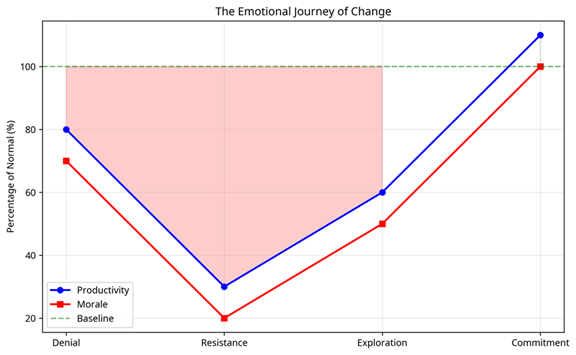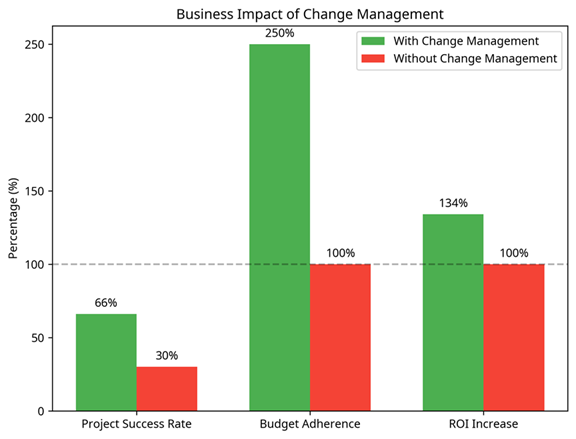Table of Contents
- The Hidden Reasons Change Initiatives Fail
- The Brain’s Response to Change
- The Emotional Journey of Change
- Common Resistance Patterns in Digital Transformation
- The Business Cost of Failed Change
- What Successful Organizations Do Differently
- The 5-Step Change Management Framework
- The Digital Adoption Platform Advantage
- Introducing Apty: The AI-Powered Change Management Solution
- Measurable Results
- Change Management Readiness Checklist
- The Cost of Inaction
- Transform Your Change Management Strategy with Apty
Do you know that despite significant investments in new technologies, a startling 70% of digital transformation initiatives fail to deliver expected outcomes. The missing link? Effective strategies for addressing critical change management challenges.
This disconnect between technology implementation and successful adoption represents one of the most costly and frustrating challenges facing modern enterprises. While executives focus on selecting the right software and systems, they often underestimate the human element of change—the very factor that determines whether their investment will yield returns or become another statistic in why change management fails.
The Hidden Reasons Change Initiatives Fail
Change resistance isn’t simply a result of organizational dysfunction or employee stubbornness—it’s rooted in fundamental aspects of human psychology and neurobiology. Overcoming resistance to change requires understanding these underlying mechanisms.
The Brain’s Response to Change
When confronted with significant changes to established routines, our brains activate a threat response system. The amygdala—our brain’s alarm system—triggers the fight-or-flight response, increasing cortisol levels and reducing cognitive function. This neurological response explains why even positive changes can trigger resistance. The brain perceives uncertainty as a potential threat, regardless of the rational benefits the change might bring.
Research shows that this response is hardwired into our neural pathways. As one neuroscience study explains, “Part of the brain—the amygdala—interprets change as a threat and releases the hormones for fear, fight, or flight. Your body is actually protecting you from change.” Managing change effectively in business means working with these biological realities, not against them.
The Emotional Journey of Change
Beyond the neurological response, individuals experiencing change typically progress through predictable emotional stages, as illustrated in the chart below:

This emotional journey shows how both productivity and morale typically dip during the resistance phase before gradually improving through exploration and eventually exceeding baseline levels once commitment is achieved. Understanding where individuals and teams are in this journey allows change leadership in enterprises to provide appropriate support at each stage.
Common Resistance Patterns in Digital Transformation
Digital transformation initiatives typically encounter several specific resistance patterns:
- Fear of Obsolescence: Employees worry that new technologies will make their skills irrelevant or eliminate their positions entirely.
- Competence Concerns: Even talented employees may resist changes that make them feel temporarily incompetent during the learning curve.
- Workload Anxiety: The perception that new systems will create additional work, especially during transition periods.
- Loss of Control: Digital systems often standardize processes, potentially reducing individual autonomy.
- Skepticism from Past Failures: In organizations with histories of unsuccessful technology implementations, employees develop “change fatigue” and cynicism.
Addressing these change management challenges requires a thoughtful, structured approach.
The Business Cost of Failed Change
The financial implications of poor change management are substantial and often underestimated. When organizations fail to address the human side of change, they face:
- Implementation costs without ROI
- Lost productivity during extended transition periods
- Increased support ticket volume and IT burden
- Data quality issues from improper system use
- Employee disengagement and turnover
Research consistently demonstrates the dramatic difference in outcomes between organizations that employ effective change management and those that don’t:

As this data shows, projects with effective change management are 2.5 times more likely to stay on or under budget, deliver results 67% more efficiently, and experience 34% higher ROI on transformation initiatives. Understanding why change management fails is the first step toward avoiding these costly outcomes.
What Successful Organizations Do Differently
Organizations that consistently succeed with change initiatives approach transformation differently. They implement successful change management strategies that have evolved significantly over the past decades:
- First Generation (1990s): Focused primarily on communication and training, with limited tools beyond spreadsheets and project plans.
- Second Generation (2000s-2010s): Introduced structured methodologies (ADKAR, Kotter, etc.) and basic change management tools.
- Third Generation (Current): Leverages data analytics, AI in change management, and digital adoption platforms to deliver personalized, adaptive change experiences at scale.
Discover how Apty can simplify your change journey with real-time, in-app guidance and ensure 100% adoption across your tools.
The 5-Step Change Management Framework
Ensuring organizational change success requires a structured approach that addresses both the technical and human elements:

- Strategic Planning: Aligning change initiatives with business objectives and identifying potential resistance points before implementation.
- Communication & Engagement: Creating transparent, two-way communication channels and involving employees in the change process.
- Training & Enablement: Providing personalized learning experiences that build confidence and competence with new systems.
- Reinforcement & Support: Offering ongoing assistance and celebrating early wins to maintain momentum.
- Measurement & Optimization: Tracking adoption metrics and business outcomes to continuously improve the change approach.
This framework represents one of the most effective digital transformation best practices when supported by critical success factors, including active executive sponsorship, dedicated change management resources, and engaged middle management.
The Digital Adoption Platform Advantage
Modern Digital Adoption Platforms (DAPs) have emerged as essential tools for bridging the gap between technology implementation and successful adoption. By providing contextual guidance, personalized support, and data-driven insights, DAPs help organizations overcome common change management challenges.
The role of AI in change management is particularly transformative, enabling:
- Personalization at Scale: Delivering customized guidance based on user role, behavior, and proficiency.
- Data-Driven Insights: Identifying adoption barriers and resistance patterns in real-time.
- Automation of Routine Aspects: Streamlining repetitive tasks to reduce cognitive load during transitions.
Organizations using DAPs are seeing a fundamental shift in how they measure change success—moving beyond basic activity metrics (like training completion rates) to business outcome metrics that directly connect to ROI. This represents a significant advancement in managing change effectively in business.
Introducing Apty: The AI-Powered Change Management Solution
Apty stands apart from traditional Digital Adoption Platforms by focusing on business outcomes rather than just software adoption. While other solutions stop at basic guidance, Apty delivers measurable business impact through its unique approach to addressing change management challenges.
Apty’s Unique Approach
Apty is a next-generation Digital Adoption Platform (DAP) designed to help organizations maximize the value of their software investments through real-time, context-aware user guidance and support. Here are some of its key features:
- Focus on Business Outcomes: Apty moves beyond adoption metrics to measure what actually matters—errors avoided, processes completed, and business performance accelerated.
- Cross-Application Workflow Support: Unlike solutions that work within single applications, Apty guides employees across your entire technology stack.
- Fast Implementation: While traditional DAPs take months to implement, Apty delivers results in weeks, not months.
- Real-Time, Contextual Guidance: Apty provides in-app, on-screen guidance at the precise moment users need it. This reduces errors, improves efficiency, and helps users navigate complex software applications more easily.
- AI-Powered Automation: The platform uses advanced machine learning and AI to predict user behavior and preemptively address challenges. This includes automated content creation, workflow guidance, and personalized task management.
- Cross-Application Support: Apty supports a seamless user experience across multiple applications, which is particularly useful for businesses with a diverse tech stack. It helps optimize workflows and ensure consistent process adherence across systems.
- Software Utilization Insights: Apty Pulse continuously monitors user behavior, tracking key metrics like software usage, engagement, and process completion. It also provides actionable insights to optimize software adoption and eliminate underutilized applications.
- Enhanced Content Creation and Analytics: Apty offers an intuitive, low-code/no-code platform for content creators to develop customized in-app guidance, including checklists, tooltips, and announcements. Additionally, it provides detailed analytics to track the performance of these content elements.
- Training and Onboarding: With Apty, organizations can streamline user onboarding with guided workflows and checklists. It also integrates with Learning Management Systems (LMS) to centralize knowledge sharing.
- Integration with Business Processes: Apty helps automate and optimize critical business processes by ensuring users follow standardized workflows, improving data quality, and ensuring compliance across applications.
- User Engagement and Feedback: The platform collects user feedback, tracks engagement levels, and measures task completion, providing a comprehensive view of the software adoption effectiveness.
These capabilities make Apty a cornerstone of successful change management strategies for forward-thinking organizations.
Measurable Results
Organizations implementing Apty consistently achieve remarkable results in employee adoption of new processes:

- 3.4x ROI in First Year: Demonstrating clear financial returns on your investment.
- 50% Faster Onboarding: Reducing time-to-productivity for new employees and system transitions.
- 30% Fewer Errors: Improving data quality and reducing costly mistakes.
- 45% Higher Process Completion Rates: Ensuring critical workflows are followed correctly.
Change Management Readiness Checklist
How prepared is your organization to tackle change management challenges? Use this quick assessment:
- Do you have active and visible executive sponsorship for change initiatives?
- Have you allocated dedicated change management resources?
- Is there a structured methodology in place for managing change?
- Are middle managers engaged and equipped to support their teams?
- Do you have transparent, two-way communication channels established?
- Are you measuring both adoption metrics and business outcomes?
- Do you have tools to provide personalized support at scale?
This checklist represents the foundation of change leadership in enterprises that consistently succeed with transformation initiatives.
The Cost of Inaction
Every day without effective change management is a day of wasted productivity and missed ROI. Organizations that delay implementing proper change management solutions face mounting costs. Understanding why change management fails helps illustrate what’s at stake:
- Continued resistance to new technologies
- Extended time-to-value for software investments
- Persistent data quality and process compliance issues
- Growing employee frustration and disengagement
Discover Apty’s Change Enablement Platform
Transform Your Change Management Strategy with Apty
Software should work for people, not the other way around. Apty ensures your software investments finally deliver the returns you deserve without the complexity, hidden costs, or guesswork of traditional solutions. By implementing digital transformation best practices, you can overcome the most persistent barriers to change.
With Apty, you can:
- Begin where it hurts most—helping your people use software without frustration
- Start seeing results in days, not months, without the complexity of traditional platforms
- Move beyond adoption metrics to business outcomes that matter
- Connect systems, optimize processes, and measure impact across your organization
Don’t let your next change initiative become another statistic in change management failures. Transform your approach to managing change effectively in business with Apty and unlock the full potential of your digital investments.
Discover how Apty can enhance your change management strategy and deliver tangible business results in ensuring organizational change success. Request a demo today.
